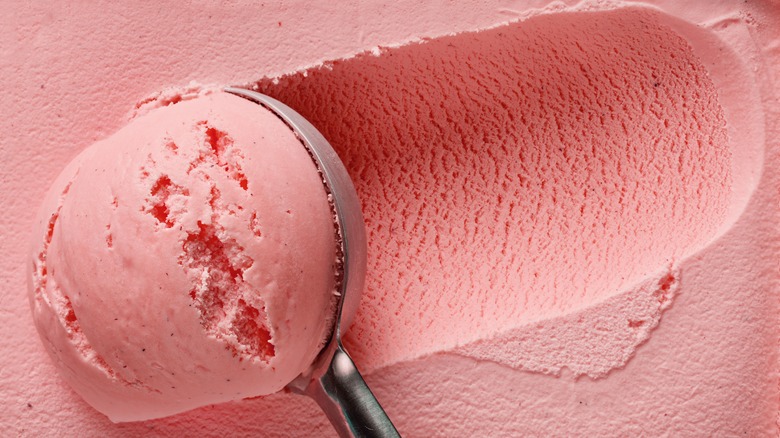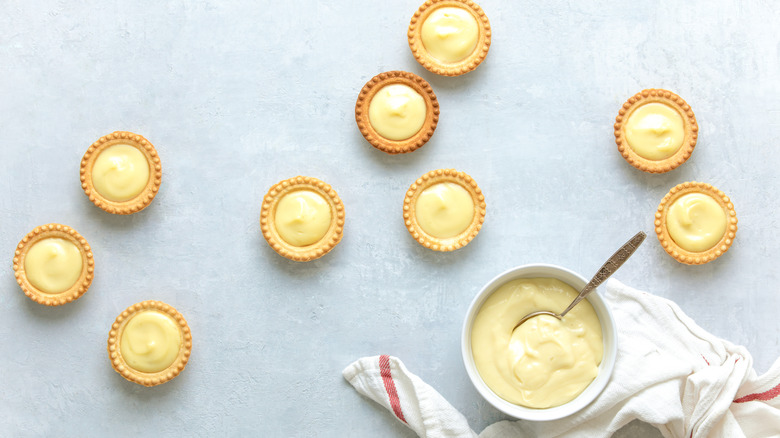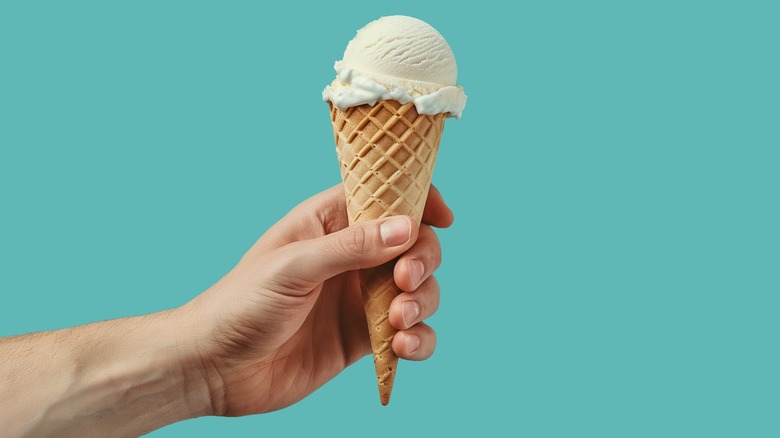What Separates Custard From Ice Cream?
Frozen custard and ice cream share similar methods and base ingredients but differ in one key component: egg yolks. Both use milk or cream and sugar, but custard also includes egg yolks while ice cream generally does not. To make frozen custard, the dairy is heated and then slowly incorporated into the egg yolks to gently cook them. After cooling, the mixture is churned in a machine that incorporates minimal air to create a dense, creamy, and richly eggy frozen treat. It has a soft texture that is easy to scoop.
Ice cream, on the other hand, is just made up of milk, cream, and sugar at its most basic. No heating is required — the mixture just needs to be whisked until the sugar dissolves. Unlike with frozen custard, ice cream churning machines are actually meant to incorporate air, yielding a lighter texture.
When ice cream and frozen custard are being sold at the supermarket, it gets a bit more confusing. According to the FDA, a creamy frozen concoction can still be called ice cream as long as it has less than 1.4% egg yolks. Custard still has to have egg yolks no matter what with a minimum level of 1.12%. When it comes to the rules and regulations around commercial packaging, a frozen custard with less than 1.4% egg yolk can also be called ice cream.
The many uses of custard
Custard is actually a broad term that encompasses any mixture of milk or cream with eggs, and it can be savory, sweet, warm, or cold. Frozen custard is just one of many preparations, and churning is what transforms it into a luscious and creamy frozen dessert. Without that step, the texture is negatively impacted by freezing. Different recipes call for widely varying measurements, so the ideal ratio all comes down to personal preferences and some trial and error.
Other forms of custard make up the base of many recipes that are likely in your rotation. The liquid in a basic bread pudding recipe is a custard, as is the egg mixture in a gooey breakfast strata. Vanilla-scented crème anglaise made on the stovetop falls into this category, and so does crème brûlée that is cooked in a water bath in the oven.
Items that are thickened with starches or flour such as pudding or pastry cream also count as long as they have eggs. Custard can be used as a pie, tart, or doughnut filling, the base of a creamy cake, a warm drizzle over a finished dessert, or in standalone dishes like flan. There is no specified ratio of milk or cream to eggs, so even dishes like quiche and frittatas start with what is technically a custard. This combination can be transformed into so many different sweet or savory finished products depending on the cooking methods and additions.
Different types of ice cream bases
Some recipes for homemade "ice cream" use a custard base, though this would technically yield a frozen custard. Despite the misnomer, ice cream bases with egg yolks are popular for the rich flavor and soft texture that they provide. A Philadelphia-style ice cream base is also a go-to. It uses just milk, cream, sugar, and flavorings, and it churns into a delicately flavored, smooth, and lightly-textured finished product.
Some recipes call for equal parts cream and milk, while others lean richer with around two parts cream to one part milk. Similar bases use emulsifiers like cornstarch and cream cheese — this style was popularized by the brand Jeni's Splendid Ice Creams. While light, creamy, delicious, and egg-free, soft serve isn't technically ice cream because it contains less than the required 10% to 16% milk fat.
As for the store bought options, ice creams at the supermarket can be made with many different configurations of these same base ingredients. For example, Ben & Jerry's uses egg yolks in its recipe, and Breyer's is a popular Philadelphia-style brand. If you simply can't decide what to buy, might we recommend grabbing a pint each of ice cream and frozen custard ... you know, for science.



